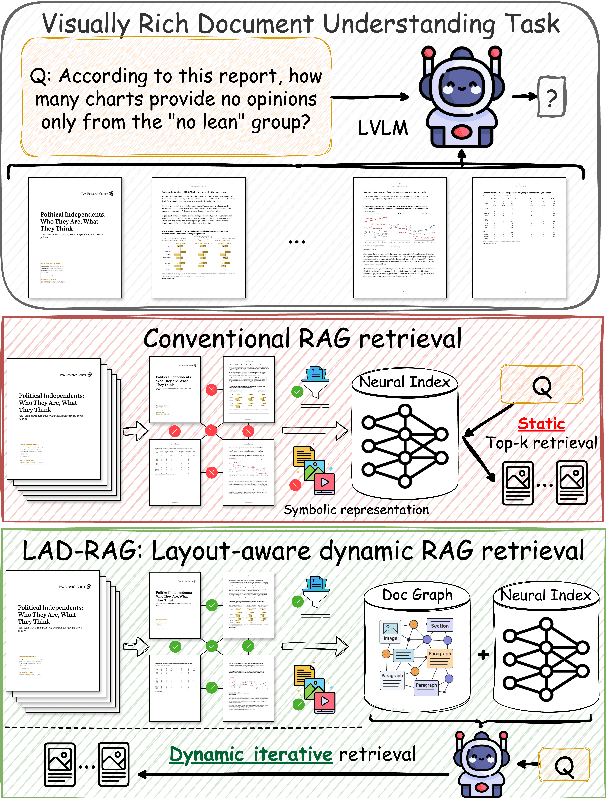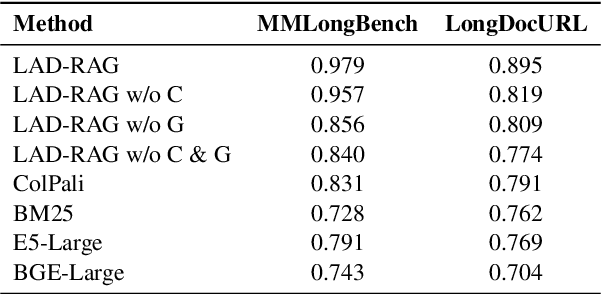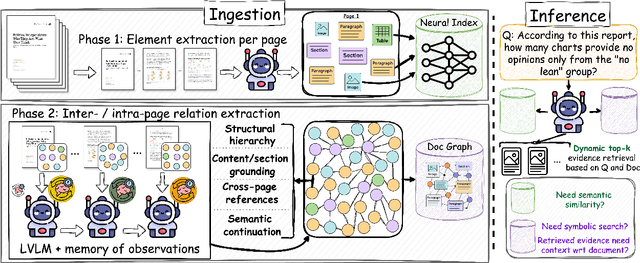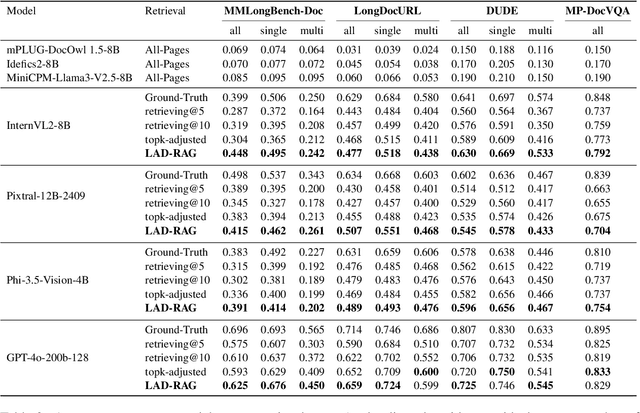Zheng Wang
Celine
LAD-RAG: Layout-aware Dynamic RAG for Visually-Rich Document Understanding
Oct 08, 2025



Abstract:Question answering over visually rich documents (VRDs) requires reasoning not only over isolated content but also over documents' structural organization and cross-page dependencies. However, conventional retrieval-augmented generation (RAG) methods encode content in isolated chunks during ingestion, losing structural and cross-page dependencies, and retrieve a fixed number of pages at inference, regardless of the specific demands of the question or context. This often results in incomplete evidence retrieval and degraded answer quality for multi-page reasoning tasks. To address these limitations, we propose LAD-RAG, a novel Layout-Aware Dynamic RAG framework. During ingestion, LAD-RAG constructs a symbolic document graph that captures layout structure and cross-page dependencies, adding it alongside standard neural embeddings to yield a more holistic representation of the document. During inference, an LLM agent dynamically interacts with the neural and symbolic indices to adaptively retrieve the necessary evidence based on the query. Experiments on MMLongBench-Doc, LongDocURL, DUDE, and MP-DocVQA demonstrate that LAD-RAG improves retrieval, achieving over 90% perfect recall on average without any top-k tuning, and outperforming baseline retrievers by up to 20% in recall at comparable noise levels, yielding higher QA accuracy with minimal latency.
OTTER: Open-Tagging via Text-Image Representation for Multi-modal Understanding
Oct 01, 2025Abstract:We introduce OTTER, a unified open-set multi-label tagging framework that harmonizes the stability of a curated, predefined category set with the adaptability of user-driven open tags. OTTER is built upon a large-scale, hierarchically organized multi-modal dataset, collected from diverse online repositories and annotated through a hybrid pipeline combining automated vision-language labeling with human refinement. By leveraging a multi-head attention architecture, OTTER jointly aligns visual and textual representations with both fixed and open-set label embeddings, enabling dynamic and semantically consistent tagging. OTTER consistently outperforms competitive baselines on two benchmark datasets: it achieves an overall F1 score of 0.81 on Otter and 0.75 on Favorite, surpassing the next-best results by margins of 0.10 and 0.02, respectively. OTTER attains near-perfect performance on open-set labels, with F1 of 0.99 on Otter and 0.97 on Favorite, while maintaining competitive accuracy on predefined labels. These results demonstrate OTTER's effectiveness in bridging closed-set consistency with open-vocabulary flexibility for multi-modal tagging applications.
Enhancing WSI-Based Survival Analysis with Report-Auxiliary Self-Distillation
Sep 19, 2025Abstract:Survival analysis based on Whole Slide Images (WSIs) is crucial for evaluating cancer prognosis, as they offer detailed microscopic information essential for predicting patient outcomes. However, traditional WSI-based survival analysis usually faces noisy features and limited data accessibility, hindering their ability to capture critical prognostic features effectively. Although pathology reports provide rich patient-specific information that could assist analysis, their potential to enhance WSI-based survival analysis remains largely unexplored. To this end, this paper proposes a novel Report-auxiliary self-distillation (Rasa) framework for WSI-based survival analysis. First, advanced large language models (LLMs) are utilized to extract fine-grained, WSI-relevant textual descriptions from original noisy pathology reports via a carefully designed task prompt. Next, a self-distillation-based pipeline is designed to filter out irrelevant or redundant WSI features for the student model under the guidance of the teacher model's textual knowledge. Finally, a risk-aware mix-up strategy is incorporated during the training of the student model to enhance both the quantity and diversity of the training data. Extensive experiments carried out on our collected data (CRC) and public data (TCGA-BRCA) demonstrate the superior effectiveness of Rasa against state-of-the-art methods. Our code is available at https://github.com/zhengwang9/Rasa.
Hammer and Anvil: A Principled Defense Against Backdoors in Federated Learning
Sep 09, 2025Abstract:Federated Learning is a distributed learning technique in which multiple clients cooperate to train a machine learning model. Distributed settings facilitate backdoor attacks by malicious clients, who can embed malicious behaviors into the model during their participation in the training process. These malicious behaviors are activated during inference by a specific trigger. No defense against backdoor attacks has stood the test of time, especially against adaptive attackers, a powerful but not fully explored category of attackers. In this work, we first devise a new adaptive adversary that surpasses existing adversaries in capabilities, yielding attacks that only require one or two malicious clients out of 20 to break existing state-of-the-art defenses. Then, we present Hammer and Anvil, a principled defense approach that combines two defenses orthogonal in their underlying principle to produce a combined defense that, given the right set of parameters, must succeed against any attack. We show that our best combined defense, Krum+, is successful against our new adaptive adversary and state-of-the-art attacks.
Behave Your Motion: Habit-preserved Cross-category Animal Motion Transfer
Jul 10, 2025Abstract:Animal motion embodies species-specific behavioral habits, making the transfer of motion across categories a critical yet complex task for applications in animation and virtual reality. Existing motion transfer methods, primarily focused on human motion, emphasize skeletal alignment (motion retargeting) or stylistic consistency (motion style transfer), often neglecting the preservation of distinct habitual behaviors in animals. To bridge this gap, we propose a novel habit-preserved motion transfer framework for cross-category animal motion. Built upon a generative framework, our model introduces a habit-preservation module with category-specific habit encoder, allowing it to learn motion priors that capture distinctive habitual characteristics. Furthermore, we integrate a large language model (LLM) to facilitate the motion transfer to previously unobserved species. To evaluate the effectiveness of our approach, we introduce the DeformingThings4D-skl dataset, a quadruped dataset with skeletal bindings, and conduct extensive experiments and quantitative analyses, which validate the superiority of our proposed model.
Convergent and divergent connectivity patterns of the arcuate fasciculus in macaques and humans
Jun 24, 2025Abstract:The organization and connectivity of the arcuate fasciculus (AF) in nonhuman primates remain contentious, especially concerning how its anatomy diverges from that of humans. Here, we combined cross-scale single-neuron tracing - using viral-based genetic labeling and fluorescence micro-optical sectioning tomography in macaques (n = 4; age 3 - 11 years) - with whole-brain tractography from 11.7T diffusion MRI. Complemented by spectral embedding analysis of 7.0T MRI in humans, we performed a comparative connectomic analysis of the AF across species. We demonstrate that the macaque AF originates in the temporal-parietal cortex, traverses the auditory cortex and parietal operculum, and projects into prefrontal regions. In contrast, the human AF exhibits greater expansion into the middle temporal gyrus and stronger prefrontal and parietal operculum connectivity - divergences quantified by Kullback-Leibler analysis that likely underpin the evolutionary specialization of human language networks. These interspecies differences - particularly the human AF's broader temporal integration and strengthened frontoparietal linkages - suggest a connectivity-based substrate for the emergence of advanced language processing unique to humans. Furthermore, our findings offer a neuroanatomical framework for understanding AF-related disorders such as aphasia and dyslexia, where aberrant connectivity disrupts language function.
Foundation Model Insights and a Multi-Model Approach for Superior Fine-Grained One-shot Subset Selection
Jun 17, 2025Abstract:One-shot subset selection serves as an effective tool to reduce deep learning training costs by identifying an informative data subset based on the information extracted by an information extractor (IE). Traditional IEs, typically pre-trained on the target dataset, are inherently dataset-dependent. Foundation models (FMs) offer a promising alternative, potentially mitigating this limitation. This work investigates two key questions: (1) Can FM-based subset selection outperform traditional IE-based methods across diverse datasets? (2) Do all FMs perform equally well as IEs for subset selection? Extensive experiments uncovered surprising insights: FMs consistently outperform traditional IEs on fine-grained datasets, whereas their advantage diminishes on coarse-grained datasets with noisy labels. Motivated by these finding, we propose RAM-APL (RAnking Mean-Accuracy of Pseudo-class Labels), a method tailored for fine-grained image datasets. RAM-APL leverages multiple FMs to enhance subset selection by exploiting their complementary strengths. Our approach achieves state-of-the-art performance on fine-grained datasets, including Oxford-IIIT Pet, Food-101, and Caltech-UCSD Birds-200-2011.
From Swath to Full-Disc: Advancing Precipitation Retrieval with Multimodal Knowledge Expansion
Jun 08, 2025Abstract:Accurate near-real-time precipitation retrieval has been enhanced by satellite-based technologies. However, infrared-based algorithms have low accuracy due to weak relations with surface precipitation, whereas passive microwave and radar-based methods are more accurate but limited in range. This challenge motivates the Precipitation Retrieval Expansion (PRE) task, which aims to enable accurate, infrared-based full-disc precipitation retrievals beyond the scanning swath. We introduce Multimodal Knowledge Expansion, a two-stage pipeline with the proposed PRE-Net model. In the Swath-Distilling stage, PRE-Net transfers knowledge from a multimodal data integration model to an infrared-based model within the scanning swath via Coordinated Masking and Wavelet Enhancement (CoMWE). In the Full-Disc Adaptation stage, Self-MaskTune refines predictions across the full disc by balancing multimodal and full-disc infrared knowledge. Experiments on the introduced PRE benchmark demonstrate that PRE-Net significantly advanced precipitation retrieval performance, outperforming leading products like PERSIANN-CCS, PDIR, and IMERG. The code will be available at https://github.com/Zjut-MultimediaPlus/PRE-Net.
SASP: Strip-Aware Spatial Perception for Fine-Grained Bird Image Classification
May 30, 2025Abstract:Fine-grained bird image classification (FBIC) is not only of great significance for ecological monitoring and species identification, but also holds broad research value in the fields of image recognition and fine-grained visual modeling. Compared with general image classification tasks, FBIC poses more formidable challenges: 1) the differences in species size and imaging distance result in the varying sizes of birds presented in the images; 2) complex natural habitats often introduce strong background interference; 3) and highly flexible poses such as flying, perching, or foraging result in substantial intra-class variability. These factors collectively make it difficult for traditional methods to stably extract discriminative features, thereby limiting the generalizability and interpretability of models in real-world applications. To address these challenges, this paper proposes a fine-grained bird classification framework based on strip-aware spatial perception, which aims to capture long-range spatial dependencies across entire rows or columns in bird images, thereby enhancing the model's robustness and interpretability. The proposed method incorporates two novel modules: extensional perception aggregator (EPA) and channel semantic weaving (CSW). Specifically, EPA integrates local texture details with global structural cues by aggregating information across horizontal and vertical spatial directions. CSW further refines the semantic representations by adaptively fusing long-range and short-range information along the channel dimension. Built upon a ResNet-50 backbone, the model enables jump-wise connection of extended structural features across the spatial domain. Experimental results on the CUB-200-2011 dataset demonstrate that our framework achieves significant performance improvements while maintaining architectural efficiency.
Rethinking Continual Learning with Progressive Neural Collapse
May 30, 2025Abstract:Continual Learning (CL) seeks to build an agent that can continuously learn a sequence of tasks, where a key challenge, namely Catastrophic Forgetting, persists due to the potential knowledge interference among different tasks. On the other hand, deep neural networks (DNNs) are shown to converge to a terminal state termed Neural Collapse during training, where all class prototypes geometrically form a static simplex equiangular tight frame (ETF). These maximally and equally separated class prototypes make the ETF an ideal target for model learning in CL to mitigate knowledge interference. Thus inspired, several studies have emerged very recently to leverage a fixed global ETF in CL, which however suffers from key drawbacks, such as impracticability and limited performance.To address these challenges and fully unlock the potential of ETF in CL, we propose Progressive Neural Collapse (ProNC), a novel framework that completely removes the need of a fixed global ETF in CL. Specifically, ProNC progressively expands the ETF target in a principled way by adding new class prototypes as vertices for new tasks, ensuring maximal separability across all encountered classes with minimal shifts from the previous ETF. We next develop a new CL framework by plugging ProNC into commonly used CL algorithm designs, where distillation is further leveraged to balance between target shifting for old classes and target aligning for new classes. Extensive experiments show that our approach significantly outperforms related baselines while maintaining superior flexibility, simplicity, and efficiency.
 Add to Chrome
Add to Chrome Add to Firefox
Add to Firefox Add to Edge
Add to Edge